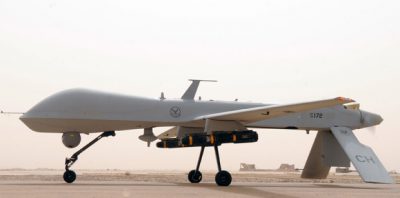New Report: Crowded Sky, Contested Sea: Drones over the South and East China Seas

Amid naval patrols, live military drills, island building, trade wars and diplomatic breakdown, drones are making an increasing impact on the security situation in the South China Sea and the relationship between China and the US. Smaller nations in the region are also acquiring further reaching surveillance UAVs, while a number of states are looking to bring armed drones in to service over the next few years.
A new report from Drone Wars UK, Contested Sea, Crowded Sky, looks at the steady acquisition of drones by smaller states in South East Asia and their deployments in the South and East China Seas that are contributing to destabilisation in the region and deteriorating relations between China and the US.
Just last week, Congress received notification from The Whitehouse of a proposed sale of a maritime version of the Reaper drone to Taiwan, while US drone crews have been recently training for Reaper operations in the pacific region (“With an Eye on China, Reaper Drones Train for Maritime War”) as part of the ‘pivot away from the Middle East’. Both incidents have greatly angered China. Caught in a super-power stand-off, smaller states in the region also have security concerns regarding contested island chains, natural resources under the sea bed and access to fishing waters. China claims many of the small island chains but most are also claimed by several smaller states. The tensions over ownership and resources are contributing to military build-up in the South and East China seas. As well as upgrading jets and naval vessels, states are investing in longer range, more persistent unmanned aerial systems (UAS) to enhance security.
For new weapons systems, South East Asian states have primarily looked to Israel, China and the US – the major drone exporters – for the latest surveillance technology and some are also investing heavily in their own capabilities, in order to acquire armed systems.
Currently, it is only China that has the capacity to operate armed drones in the region, although Indonesia has purchased Chinese CH-4B drones and is designing their own version, the MALE Elang Hitam (Black Eagle), which the manufacturers hope will be fully certified by 2024. Thailand too, are working towards an armed drone – an upgraded version of the SkyScouttactical drone.
Unarmed surveillance drones are also adding to air and maritime capabilities. The report covers the recent US deal with four South East Asian nations for Scan Eagle 2 drones, worth $47mn. Meanwhile, Taiwan, has fielded a tactical drone, the Chung Shyang 2 in 2019 for coastal monitoring.
There are also a growing number of larger drones in service, primarily Israeli exports. Singapore, Vietnam and the Philippines have signed deals for or have in service Heron and Hermes models respectively. The US has also sanctioned the export of Northrop Grumman’s HALE Global Hawk to Japan and South Korea, while Singapore is exploring a future Global Hawk purchase.
The report also covers China’s drone use in South and East China Sea. Having first escalated tensions with Japan in 2013 in the East China Sea by flying the BZK-005 in contested airspace over the Senkaku/Daioyu islands, there is now a new drone programme with the Ministry of Natural Resources that observers think may be connected to the People’s Liberation Army Navy (PLAN). Either way, its gives Chinese authorities much more surveillance capacity in disputed areas where neighbouring states are also ramping up security and surveillance.
Drones make up only part of this military build-up in the South and East China Seas, where island and peninsular nations rely on other aircraft and naval vessels for security. However, drones are increasingly favoured for their wide-ranging surveillance capabilities, particularly models that can be launched from frigates, such as the Scan Eagle. China’s project with the Ministry of Natural Resources, noted above, will allow it specifically to collect surveillance from around disputed islets and reefs. And if the Japanese deal with the US for Global Hawk goes ahead, for example, this will give Japanese defence forces wide ranging and persistent surveillance potentially over disputed East China Sea territories like the Senkaku/Diaoyu islands.
Report author Joanna Frew discusses drone proliferation and the South China Sea
The problem with an increasing array of drones over these contested seas are that, although mostly unarmed (for now), they can enhance targeting capacity, can take more risks than manned aircraft and are thus more likely to be used in contested air space. However, this is not a region where state authority has broken down allowing a ‘permissive’ airspace – such as in Libya or Afghanistan and Somalia. Rather, missteps or overreach could result in serious repercussions from neighbouring states.
As the proliferation of drones continues without any international agreements on standards for use, the increasing of addition of drones in the South and East Asian region highlights how another region is succumbing to a drone race to retain a strategic advantage over neighbours and adversaries. The reality is that drones lower the threshold for the use of force and make armed conflict more likely. Adding this dangerous technology into this highly militarised zone could fan the flames of any smouldering conflict and turn it into a conflagration.
*
Note to readers: please click the share buttons above or below. Forward this article to your email lists. Crosspost on your blog site, internet forums. etc.

